Using MA-rFTIR Mapping as a Tool to Assess the Efficacy of Cleaning Treatments and to Aid in the Restoration Activities of Paintings
Abstract
:1. Introduction
2. Materials and Methods
2.1. The Paintings
2.1.1. A 13th-Century Wooden Painted Cross
2.1.2. A Panel Painting Titled “Madonna in Trono con Bambino, Miracolo delle Stimmate di San Francesco, Santi Antonio Abate e Bartolomeo, Crocefissione, San Cristoforo” by Arcangelo Di Cola
2.2. Micro-Destructive Method
Micro-FTIR
2.3. Non-Invasive Methods
2.3.1. Point-by-Point Reflection FTIR Spectroscopy
2.3.2. MA-rFTIR
2.4. Cleaning Treatments
2.4.1. The 13th-Century Wooden Painted Cross
2.4.2. The Panel Painting Titled “Madonna in Trono con Bambino, Miracolo delle Stimmate di San Francesco, Santi Antonio Abate e Bartolomeo, Crocefissione, San Cristoforo” by Arcangelo Di Cola
3. Results and Discussion
3.1. The 13th-Century Wooden Painted Cross
- -
- Beeswax characterized by the bands at 2954 cm−1 (asymmetric stretching of CH3), 2910 and 2850 cm−1 (stretching mode of CH2), 1737 cm−1 (C=O stretching mode), 1463 cm−1 (CH2 scissoring mode), 1173 cm−1 (C=O stretching and CH bending vibrations) and 720 cm−1 (CH2 rocking mode) [38];
- -
- -
- Calcium oxalate detected by the band at 1320 cm−1 (C-O stretching mode) [41];
- -
- Proteins revelated by the bands at 1650 and 1550 cm−1, attributed to the carbonyl stretching vibration (C=O) of the amide I and to a mixture of N-H bending and C-N stretching modes of the amide II, respectively [42].
- -
- Area A represents the untreated surface, encompassing a superimposed layer covering the pictorial layer.
- -
- Area B corresponds to the region subjected to chemical cleaning.
- -
- Area C involves a combination of laser ablation and chemical cleaning.
3.2. Panel Painting Titled “Madonna in Trono con Bambino, Miracolo delle Stimmate di San Francesco, Santi Antonio Abate e Bartolomeo, Crocefissione, San Cristoforo” by Arcangelo di Cola
4. Conclusions
Author Contributions
Funding
Institutional Review Board Statement
Informed Consent Statement
Data Availability Statement
Acknowledgments
Conflicts of Interest
References
- Ciofini, D.; Striova, J.; Camaiti, M.; Siano, S. Photo-oxidative kinetics of solvent and oil-based terpenoid varnishes. Polym. Degrad. Stab. 2016, 123, 47–61. [Google Scholar] [CrossRef]
- Mallégol, J.; Gonon, L.; Lemaire, J.; Gardette, J.L. Long-term behaviour of oil-based varnishes and paints 4. Influence of film thickness on the photooxidation. Polym. Degrad. Stab. 2001, 72, 191–197. [Google Scholar] [CrossRef]
- Casadio, F.; Keune, K.; Noble, P.; Van Loon, A.; Hendriks, E.; Centeno, S.A.; Osmond, G. (Eds.) Metal Soaps in Art; Springer: Berlin/Heidelberg, Germany, 2019. [Google Scholar] [CrossRef]
- Monico, L.; Rosi, F.; Miliani, C.; Daveri, A.; Brunetti, B.G. Non-invasive identification of metal-oxalate complexes on polychrome artwork surfaces by reflection mid-infrared spectroscopy. Spectrochim. Acta Part A Mol. Biomol. Spectrosc. 2013, 116, 270–280. [Google Scholar] [CrossRef] [PubMed]
- Matsuda, Y.; Ono, S.; Mizuochi, T.; Sanada, S.; Katagiri, M. Cleaning paintings using in situ monitoring with complementary imaging techniques: Three-dimensional morphological measurements and reflection FTIR spectroscopy. In Proceedings of the ICOM-CC 19th Triennial Conference, Beijing, China, 14–18 September 2020. [Google Scholar]
- Pereira, L.B. UV fluorescence photography of works of art: Replacing the traditional UV cut filters with interference filters. Int. J. Conserv. Sci. 2010, 1, 161–166. [Google Scholar]
- Aldovrandi, A.V. Caratterizzazione dei materiali pittorici nelle pitture murali mediante tecniche fotografiche. OPD Restauro 2011, 22, 55–80. [Google Scholar]
- Cardinali, M.; De Ruggieri, M.B.; Falcucci, C. Diagnostica Artistica: Tracce Materiali per la Storia Dell’arte e per la Conservazione; Palombi: Roma, Italy, 2007; ISBN 8860600529. [Google Scholar]
- Pelagotti, A.; Pezzati, L.; Piva, A.; Mastio, A. Del Multispectral uv Fluorescence Analysis of Painted Surfaces. In Proceedings of the 14th European Signal Processing Conference (EUSIPCO 2006), Florence, Italy, 4–8 September 2006; p. 5. [Google Scholar]
- Liang, H. Advances in multispectral and hyperspectral imaging for archaeology and art conservation. Appl. Phys. A Mater. Sci. Process. 2012, 106, 309–323. [Google Scholar] [CrossRef]
- Thoury, M.; Elias, M.; Frigerio, J.M.; Barthou, C. Nondestructive Varnish Identification by Ultraviolet Fluorescence Spectroscopy. Appl. Spectrosc. 2007, 61, 1275–1282. [Google Scholar] [CrossRef] [PubMed]
- Nevin, A.; Echard, J.P.; Thoury, M.; Comelli, D.; Valentini, G.; Cubeddu, R. Excitation emission and time-resolved fluorescence spectroscopy of selected varnishes used in historical musical instruments. Talanta 2009, 80, 286–293. [Google Scholar] [CrossRef] [PubMed]
- Nevin, A.; Comelli, D.; Osticioli, I.; Toniolo, L.; Valentini, G.; Cubeddu, R. Assessment of the ageing of triterpenoid paint varnishes using fluorescence, Raman and FTIR spectroscopy. Anal. Bioanal. Chem. 2009, 395, 2139–2149. [Google Scholar] [CrossRef]
- Marinelli, M.; Pasqualucci, A.; Romani, M.; Verona-Rinati, G. Time resolved laser induced fluorescence for characterization of binders in contemporary artworks. J. Cult. Herit. 2017, 23, 98–105. [Google Scholar] [CrossRef]
- Pronti, L.; Romani, M.; Verona-Rinati, G.; Tarquini, O.; Colao, F.; Colapietro, M.; Pifferi, A.; Cestelli-Guidi, M.; Marinelli, M. Post-Processing of VIS, NIR, and SWIR Multispectral Images of Paintings. New Discovery on the The Drunkenness of Noah, Painted by Andrea Sacchi, Stored at Palazzo Chigi (Ariccia, Rome). Heritage 2019, 2, 2275–2286. [Google Scholar] [CrossRef]
- Góra, M.; Targowski, P.; Kowalczyk, A.; Marczak, J.; Rycyk, A. Fast spectral Optical Coherence Tomography for monitoring of varnish ablation process. In Lasers in the Conservation of Artworks; CRC Press: Boca Raton, FL, USA, 2008; pp. 23–27. [Google Scholar] [CrossRef]
- Prati, S.; Sciutto, G.; Mazzeo, R.; Torri, C.; Fabbri, D. Application of ATR-far-infrared spectroscopy to the analysis of natural resins. Anal. Bioanal. Chem. 2011, 399, 3081–3091. [Google Scholar] [CrossRef]
- Moretti, P.; Rosi, F.; Miliani, C.; Daugherty, M.; van den Berg, K.J.; Cartechini, L. Non-invasive reflection FT-IR spectroscopy for on-site detection of cleaning system residues on polychrome surfaces. Microchem. J. 2020, 157, 105033. [Google Scholar] [CrossRef]
- Cestelli Guidi, M.; Pronti, L.; Romani, M.; Piccirillo, A.; Tranquilli, G. Applications of portable infrared spectroscopy (FT-IR) for monitoring of cleaning treatments on painted surfaces. In Proceedings of the 2nd Conference DTC Lazio-Centre of Excellence (Lazio Technological District for Cultural Heritage), Rome, Italy, 4 November 2021; Camilla Arcangioli, M.S.S., Ed.; L’Erma di Bretschneider: Rome, Italy, 2022. [Google Scholar]
- Carretti, E.; Rosi, F.; Miliani, C.; Dei, L. Monitoring of Pictorial Surfaces by mid-FTIR Reflectance Spectroscopy: Evaluation of the Performance of Innovative Colloidal Cleaning Agents. Spectrosc. Lett. 2005, 38, 459–475. [Google Scholar] [CrossRef]
- Iwanicka, M.; Moretti, P.; van Oudheusden, S.; Sylwestrzak, M.; Cartechini, L.; van den Berg, K.J.; Targowski, P.; Miliani, C. Complementary use of Optical Coherence Tomography (OCT) and Reflection FTIR spectroscopy for in-situ non-invasive monitoring of varnish removal from easel paintings. Microchem. J. 2018, 138, 7–18. [Google Scholar] [CrossRef]
- Dal Fovo, A.; Martínez-Weinbaum, M.; Oujja, M.; Castillejo, M.; Fontana, R. Reflectance Spectroscopy as a Novel Tool for Thickness Measurements of Paint Layers. Molecules 2023, 28, 4683. [Google Scholar] [CrossRef]
- Rosi, F.; Miliani, C.; Braun, R.; Harig, R.; Sali, D.; Brunetti, B.G.; Sgamellotti, A. Molecular Imaging of Paintings Noninvasive Analysis of Paintings by Mid-infrared Hyperspectral Imaging. Angew. Chem. Int. Ed 2013, 52, 5258–5261. [Google Scholar] [CrossRef]
- Alfeld, M. MA-XRF for Historical Paintings: State of the Art and Perspective. Microsc. Microanal. 2020, 26, 72–75. [Google Scholar] [CrossRef]
- Gómez-Morón, M.A.; Ortiz, R.; Colao, F.; Fantoni, R.; Gómez-Villa, J.L.; Becerra, J.; Ortiz, P. Monitoring the Restoration of a Seventeenth-Century Wooden Artwork Using Laser-Induced Fluorescence and Digital Image Analysis. Appl. Spectrosc. 2021, 75, 70–80. [Google Scholar] [CrossRef]
- Legrand, S.; Alfeld, M.; Vanmeert, F.; De Nolf, W.; Janssens, K. Macroscopic Fourier transform infrared scanning in reflection mode (MA-rFTIR), a new tool for chemical imaging of cultural heritage artefacts in the mid-infrared range. Analyst 2014, 139, 2489–2498. [Google Scholar] [CrossRef]
- Rosi, F.; Daveri, A.; Moretti, P.; Brunetti, B.G.; Miliani, C. Interpretation of mid and near-infrared reflection properties of synthetic polymer paints for the non-invasive assessment of binding media in twentieth-century pictorial artworks. Microchem. J. 2016, 124, 898–908. [Google Scholar] [CrossRef]
- Mobaraki, N.; Amigo, J.M. HYPER-Tools. A graphical user-friendly interface for hyperspectral image analysis. Chemom. Intell. Lab. Syst. 2018, 172, 174–187. [Google Scholar] [CrossRef]
- Amigo, J.M.; Babamoradi, H.; Elcoroaristizabal, S. Hyperspectral image analysis. Tutorial. Anal. Chim. Acta 2015, 896, 34–51. [Google Scholar] [CrossRef]
- Neto, A.M.; Victorino, A.C.; Fantoni, I.; Zampieri, D.E.; Ferreira, J.V.; Lima, D.A. Image processing using Pearson’s correlation coefficient: Applications on autonomous robotics. In Proceedings of the 2013 13th International Conference on Autonomous Robot Systems, Lisbon, Portugal, 24 April 2013. [Google Scholar] [CrossRef]
- Lippi, D.; Cianca, E.; Sinceri, I.; Fumelli, F.; Tranquilli, G.; Ioele, M. Studio e intervento di restauro di un raro esempio di quadro-tabernacolo composto da una Croce medievale, in Kermes, 130, 2013, 25–34. ISBN 9788832029628.
- Signorini, E.; Cremonesi, P. Un Approccio Alla Pulitura Dei Dipinti Mobili; Talenti, Il Prato: Prato, Italy, 2013; 256p, ISBN 10 8863361916. [Google Scholar]
- Cremonesi, P. L’ambiente Acquoso per la Pulitura di Opere Policrome; Talenti, Il Prato: Prato, Italy, 2011; 112p, ISBN 10 8863361193. [Google Scholar]
- Cremonesi, P. L’ambiente Acquoso per il Trattamento di Manufatti Artistici; Talenti, Il Prato: Prato, Italy, 2019; 128p, ISBN 10 8863364885. [Google Scholar]
- Cianca, E.; Sinceri, I.; Fumelli, F.; Ioele, M.; Priori, G.; Pronti, L.; Cestelli Guidi, M.; Romani, M.; Gorga, E.; Viviani, G.; et al. Applicazione laser Er:YAG e Nd:YAG per la pulitura di una croce dipinta del XIII secolo, Atti del convegno Aplar 8, Napoli 13–15 Dicembre 2023, in press.
- Chiara Riedo, C.; Caldera, F.; Poli, T.; Chiantore, O. Poly(vinylalcohol)-borate hydrogels with improved features for the cleaning of cultural heritage surfaces. Herit Sci. 2015, 23, 11. [Google Scholar] [CrossRef]
- Altobelli, A.; Cennamo, P.; Trojsi, G.; Barone Limaga, M.R.; Carpentieri, A.; Fatigati, G. Experimentation of a PVA-Borax hydrogel for the removal of Paraloid B72® from artifacts of archaeological interest from the National Archaeological Museum in Naples, Italy. Acta IMEKO 2023, 12, 3. [Google Scholar] [CrossRef]
- Svečnjak, L.; Baranović, G.; Vinceković, M.; Prđun, S.; Bubalo, D.; Tlak Gajger, I. An Approach for Routine Analytical Detection of Beeswax Adulteration Using FTIR-ATR Spectroscopy. J. Apic. Res. 2015, 59, 37–49. [Google Scholar] [CrossRef]
- Salvadori, B.; Errico, V.; Mauro, M.; Melnik, E.; Dei, L. Evaluation of Gypsum and Calcium Oxalates in Deteriorated Mural Paintings by Quantitative FTIR Spectroscopy. Spectrosc. Lett. Int. J. Rapid Commun. 2006, 36, 501–513. [Google Scholar] [CrossRef]
- Bishop, J.L.; Lane, M.D.; Dyar, M.D.; King, S.J.; Brown, A.J.; Swayze, G.A. Spectral properties of Ca-sulfates: Gypsum, bassanite, and anhydrite. Am. Mineral. 2014, 99, 2105–2115. [Google Scholar] [CrossRef]
- White, R.L. Infrared Spectroscopic Investigations of Calcium Oxalate Monohydrate (Whewellite) Dehydration/Rehydration. Minerals 2023, 13, 783. [Google Scholar] [CrossRef]
- Barth, A. Infrared spectroscopy of proteins. Biochim. et Biophys. Acta 2007, 1767, 1073–1101. [Google Scholar] [CrossRef]
- Invernizzi, C.; Rovetta, T.; Licchelli, M.; Malagodi, M. Mid and Near-Infrared Reflection Spectral Database of Natural Organic Materials in the Cultural Heritage Field. Int. J. Anal. Chem. 2018, 2018, 7823248. [Google Scholar] [CrossRef]
- Rosi, F.; Cartechini, L.; Monico, L.; Gabrieli, F.; Vagnini, M.; Buti, D.; Doherty, B.; Anselmi, C.; Brunetti, B.G.; Miliani, C. Tracking Metal Oxalates and Carboxylates on Painting Surfaces by Non-invasive Reflection Mid-FTIR Spectroscopy. In Metal Soaps in Art; Springer: Berlin/Heidelberg, Germany, 2019; pp. 173–193. [Google Scholar] [CrossRef]
- Asyana, V.; Haryanto, F.; Fitri, L.A.; Ridwan, T.; Anwary, F.; Soekersi, H. Analysis of urinary stone based on a spectrum absorption FTIR-ATR. J. Phys. Conf. Ser. 2016, 694, 012051. [Google Scholar] [CrossRef]
- Jones, F. Infrared investigation of barite and gypsum crystallization: Evidence for an amorphous to crystalline transition. CrystEngComm 2012, 14, 8374–8381. [Google Scholar] [CrossRef]
- Madejová, J.; Gates, W.P.; Petit, S. Chapter 5—IR Spectra of Clay Minerals. In Bergaya, Developments in Clay Science; Gates, W.P., Kloprogge, J.T., Madejová, J., Eds.; Elsevier: Amsterdam, The Netherlands, 2017; Volume 8, pp. 107–149. ISBN 9780081003558. [Google Scholar] [CrossRef]
- Bishop, J.L. Chapter 3—Remote Detection of Phyllosilicates on Mars and Implications for Climate and Habitability. In Grin, from Habitability to Life on Mars; Nathalie, A., Edmond, A.C., Eds.; Elsevier: Amsterdam, The Netherlands, 2018; pp. 37–75. ISBN 9780128099353. [Google Scholar] [CrossRef]
- Saikia, B.J. Spectroscopic Estimation of Geometrical Structure Elucidation in Natural SiO2 Crystal. J. Mater. Phys. Chem. 2014, 2, 28–33. [Google Scholar] [CrossRef]
- Chukanov, N.V. Infrared Spectra of Mineral Species; Springer: Berlin/Heidelberg, Germany, 2014; Volume 1, ISBN 978-94-007-7127-7. [Google Scholar]
- Volpi, F.; Vagnini, M.; Vivani, R.; Malagodi, M.; Fiocco, G. Non-invasive identification of red and yellow oxide and sulfide pigments in wall-paintings with portable ER-FTIR spectroscopy. J. Cult. Herit. 2023, 63, 158–168. [Google Scholar] [CrossRef]
- Miliani, C.; Rosi, F.; Daveri, A.; Brunetti, B.G. Reflection infrared spectroscopy for the non-invasive in situ study of artists’ pigments. Appl. Phys. A Mater. Sci. Process. 2012, 106, 295–307. [Google Scholar] [CrossRef]
- Vetter, W.; Latini, I.; Schreiner, M. Azurite in medieval illuminated manuscripts: A refection-FTIR study concerning the characterization of binding media. Herit Sci. 2019, 7, 21. [Google Scholar] [CrossRef]
- Otero, V.; Sanches, D.; Montagner, C.; Vilarigues, M.; Carlyle, L.; Lopes, J.A.; Melo, M.J. Characterisation of metal carboxylates by Raman and infrared spectroscopy in works of art. J. Raman Spectrosc. 2013, 45, 1197–1206. [Google Scholar] [CrossRef]
- Bruni, S.; Cariati, F.; Casadio, F.; Toniolo, L. Spectrochemical characterization by micro-FTIR spectroscopy of blue pigments in different polychrome works of art. Vib. Spectrosc. 1999, 20, 15–25. [Google Scholar] [CrossRef]
- Favaro, M.; Guastoni, A.; Marini, F.; Bianchin, S.; Gambirasi, A. Characterization of lapis lazuli and corresponding purified pigments for a provenance study of ultramarine pigments used in works of art. Anal. Bioanal. Chem. 2012, 402, 2195–2208. [Google Scholar] [CrossRef] [PubMed]

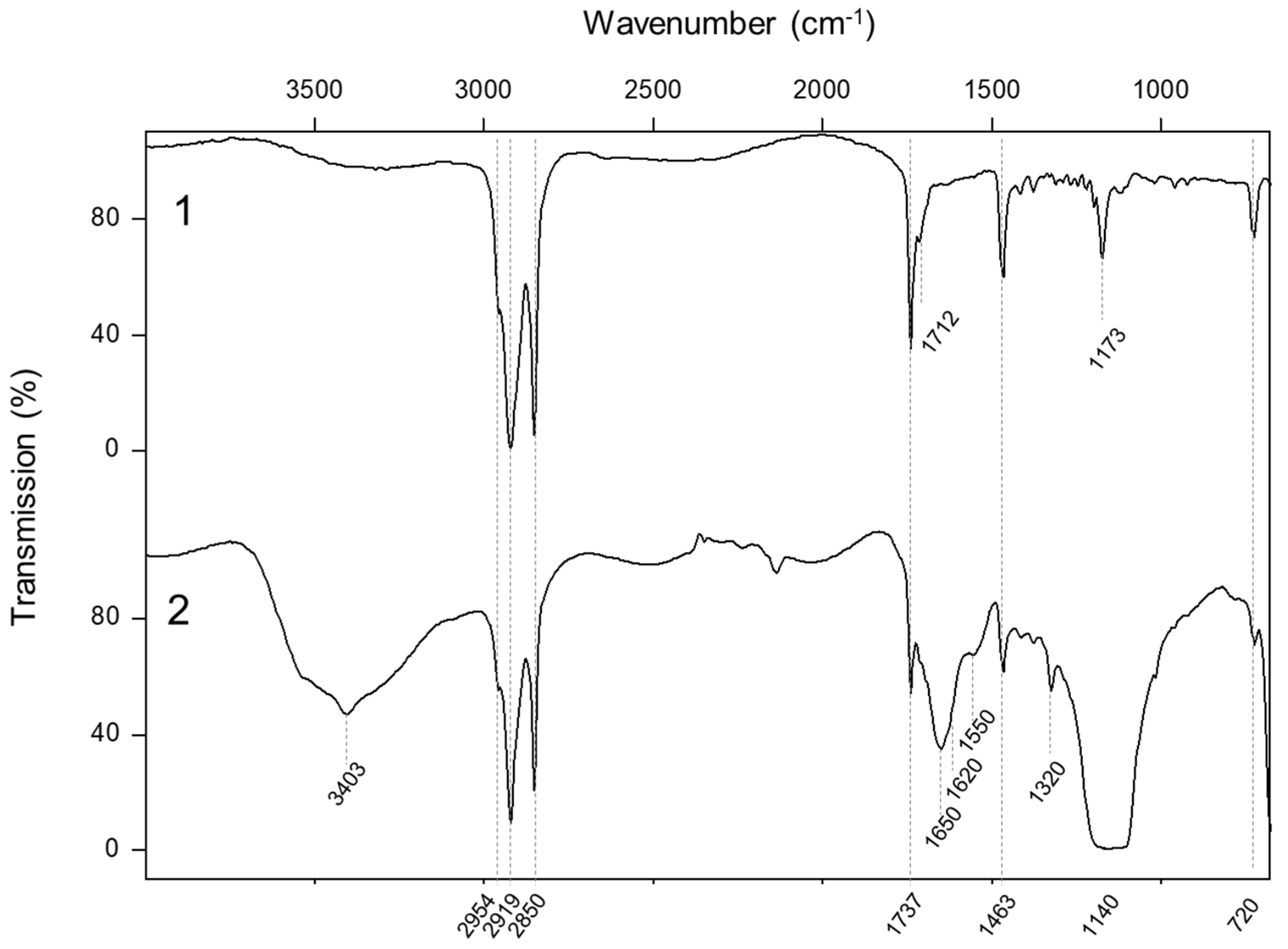
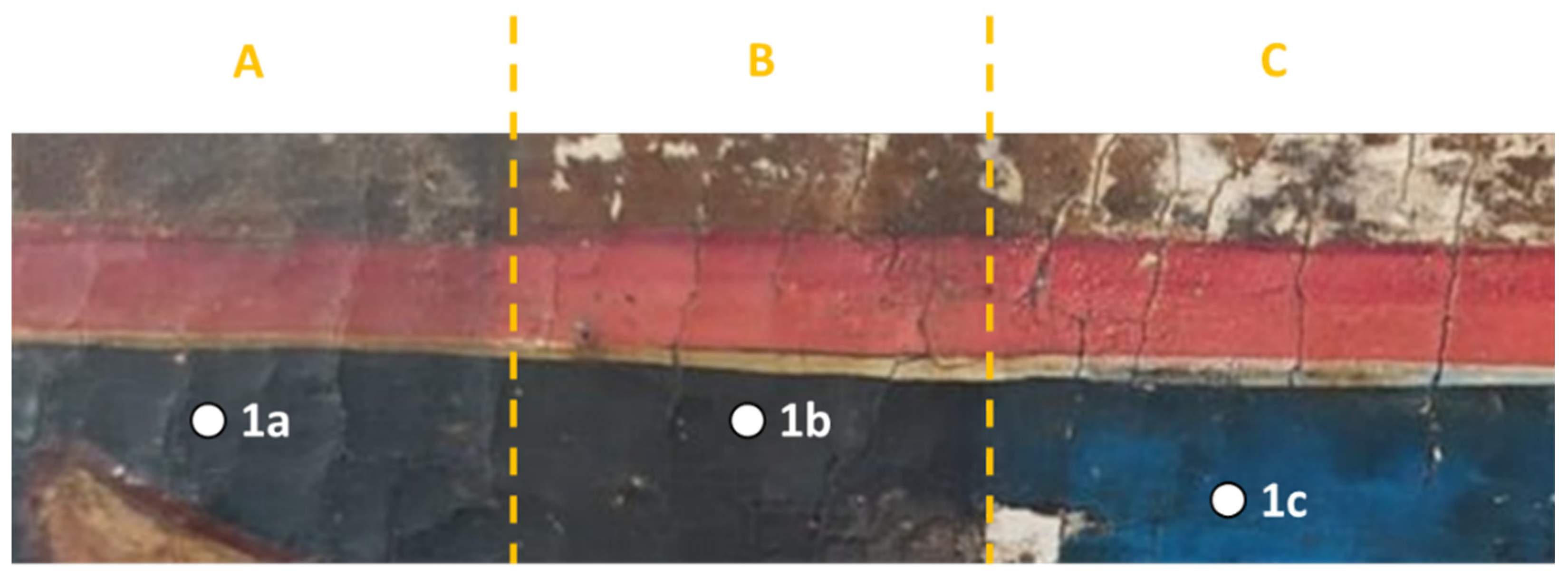


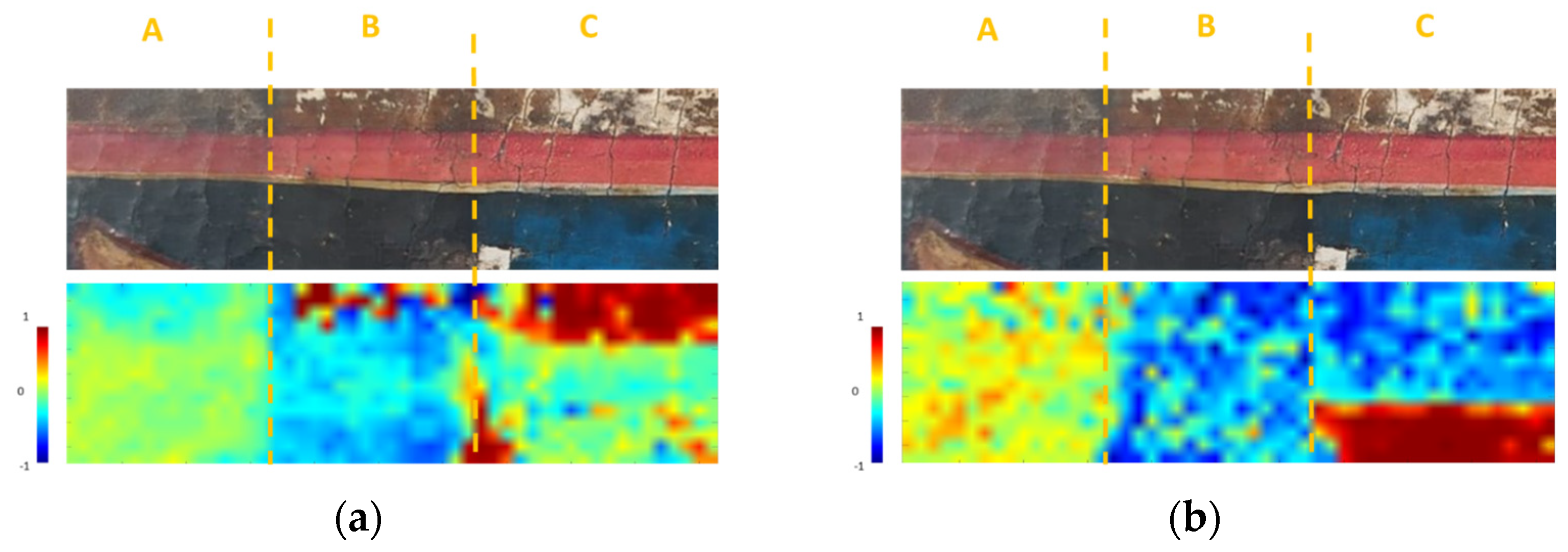

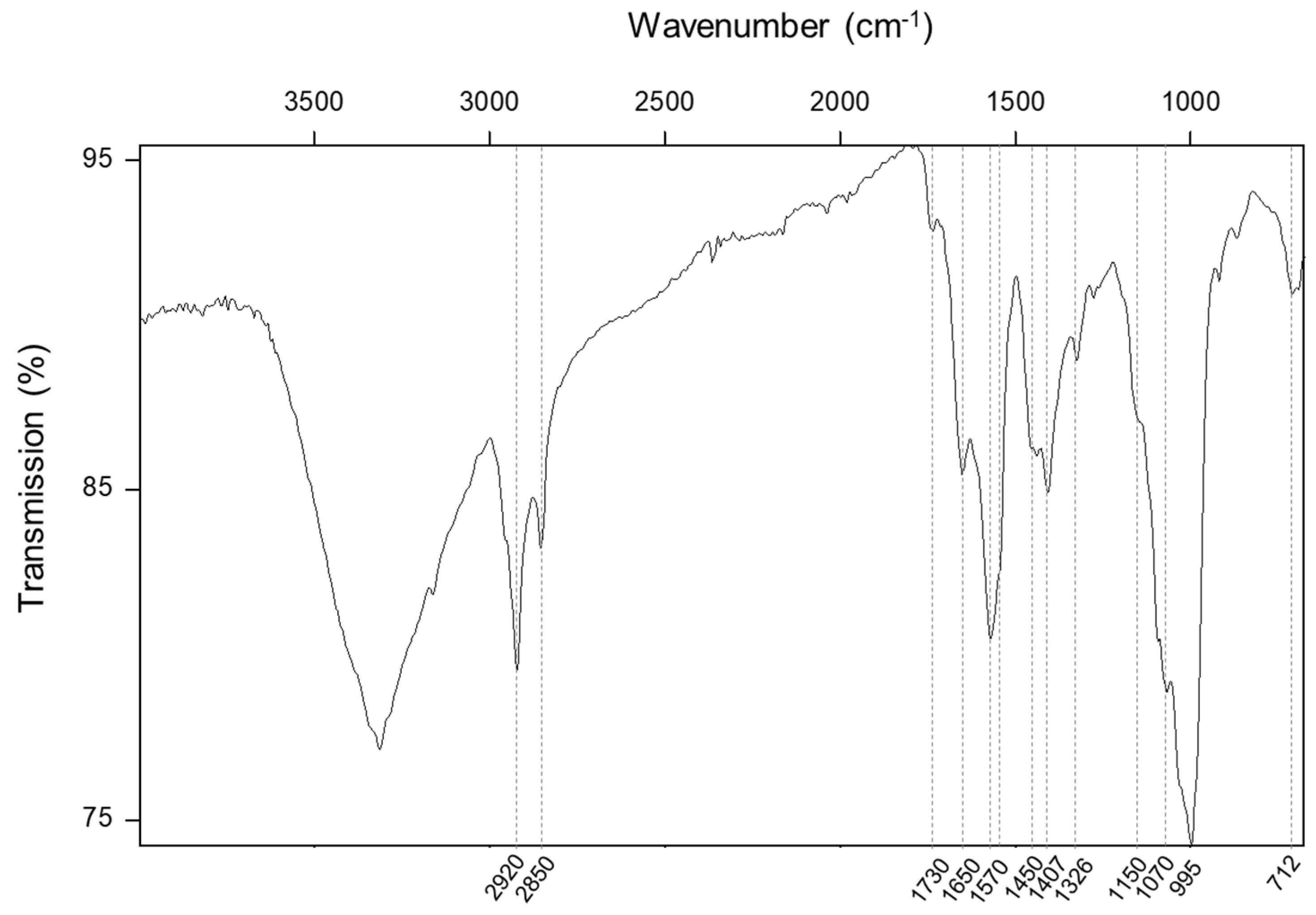
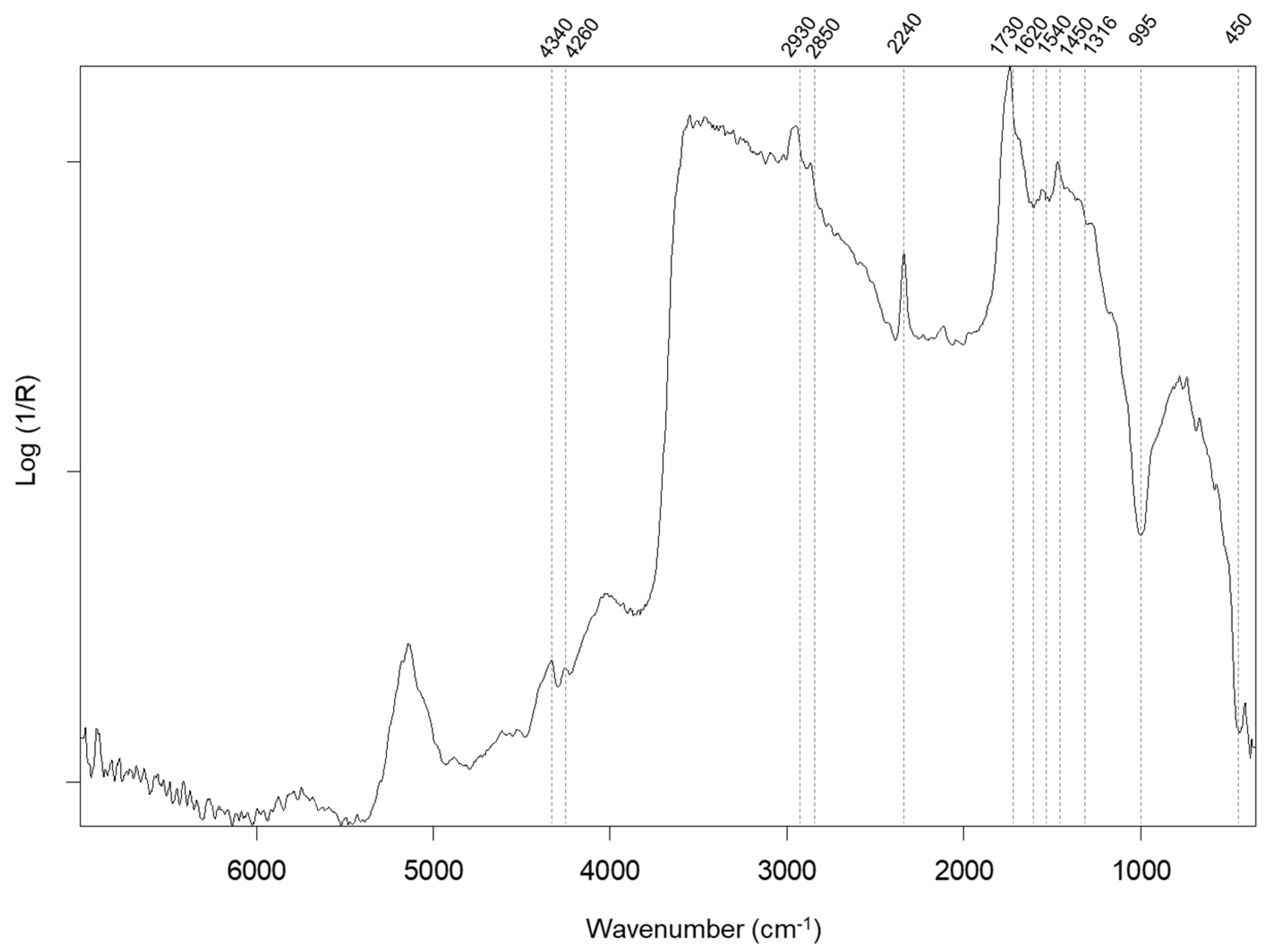
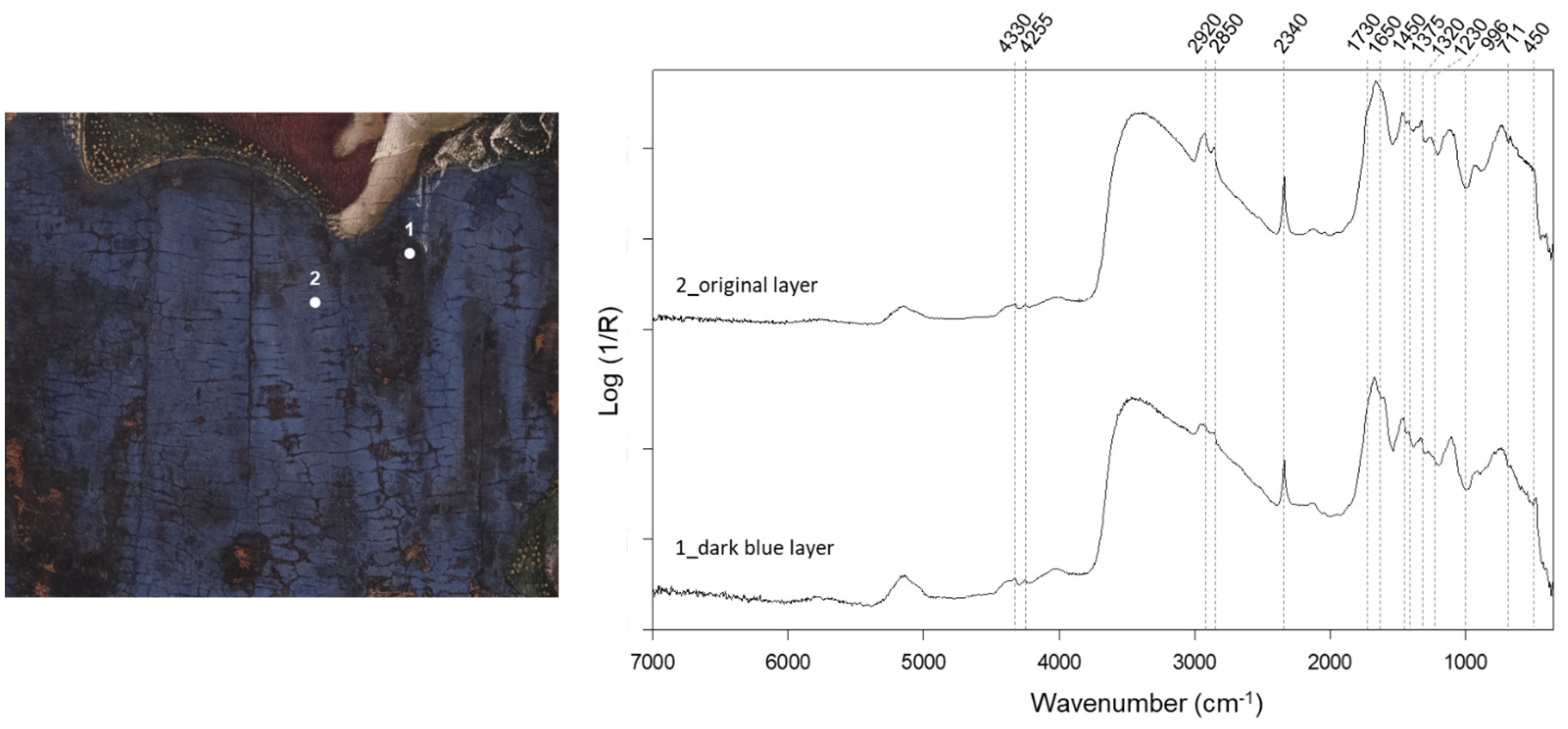
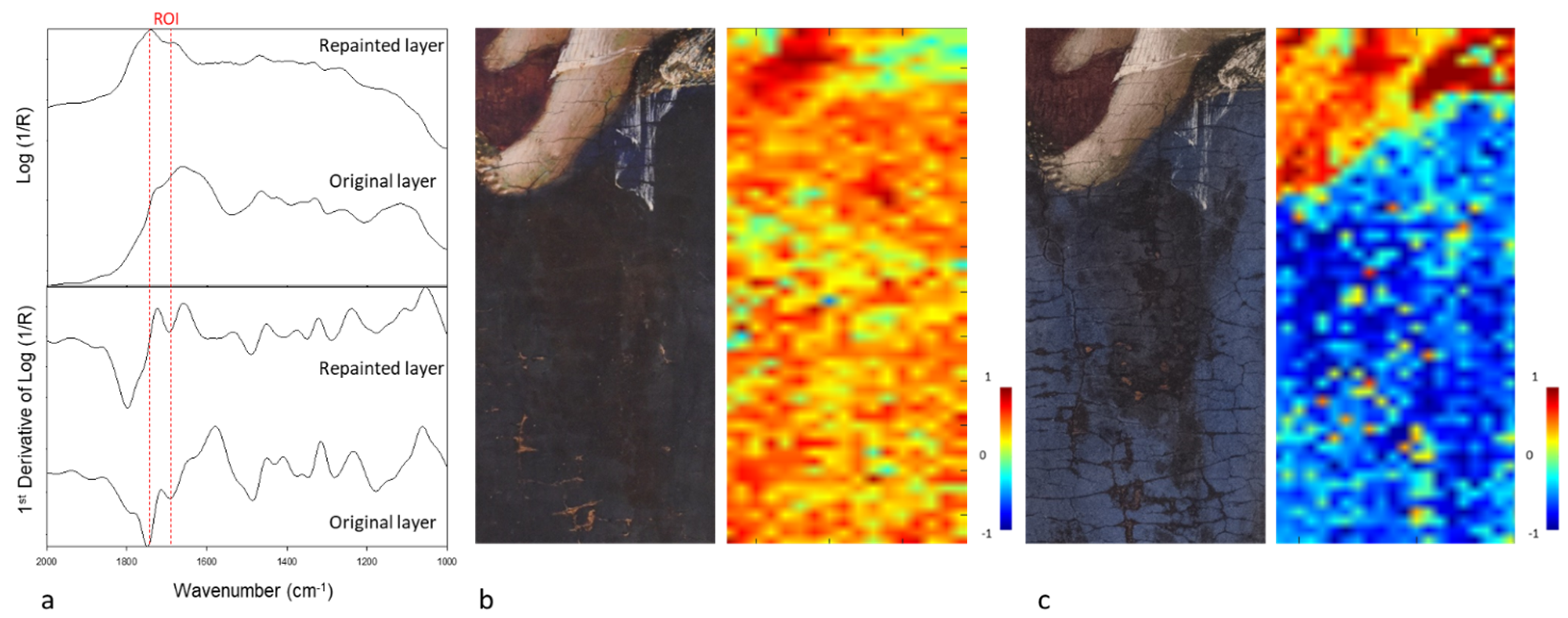
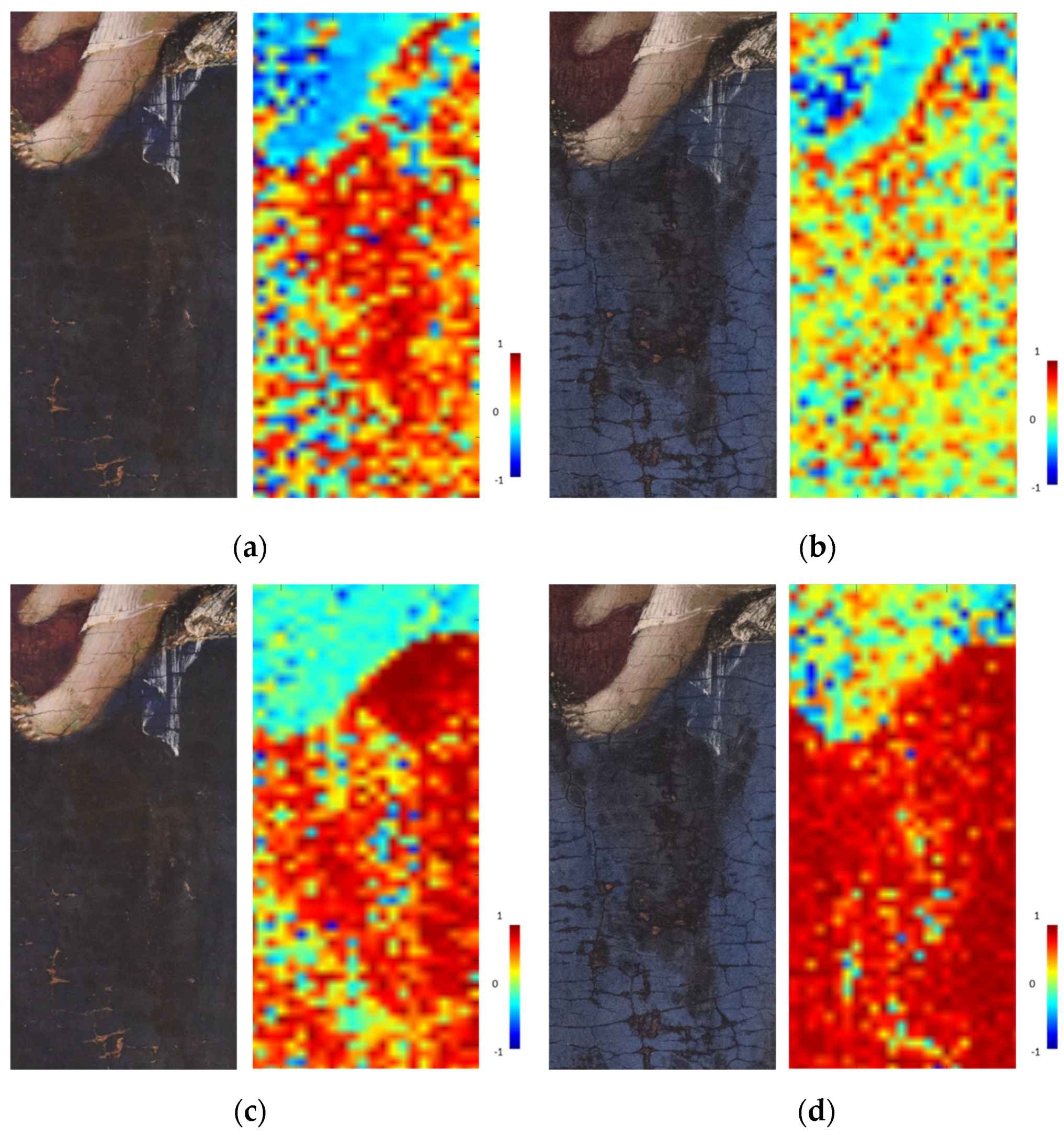
| Wavenumber (cm−1) | 1a | 1b | 1c | Band Assignment |
|---|---|---|---|---|
| 4376 | x | x | x | overtone 3ν3 of CO32− (azurite) [52] |
| 4330 | x | x | x | νa + δa of the aliphatic methylene groups (lipid content) [27] |
| 4261 | x | x | x | νs + δs of the aliphatic methylene groups (lipid content) [27] |
| 4250 | x | x | x | ν + δ (OH) (azurite) [52] |
| 3440 * | - | - | x | OH stretching mode (azurite) [52] |
| 3400 + | x | x | x | O-H stretching mode (gypsum) [52] |
| 2929 + | x | x | x | asymmetric stretching mode of CH2 (lipid content) [43] |
| 2860 + | x | - | x | symmetric stretching mode of CH2 (lipid content) [43] |
| 2590 | - | - | x | ν1 + ν3 combination band of CO32− (azurite) [52] |
| 2555 | - | - | x | ν1 + ν3 combination band of CO32− (azurite) [52] |
| 2503 | - | - | x | ν1 + ν3 combination band of CO32− (azurite) [52] |
| 1730 + | x | - | - | C=O stretching mode (lipid content) [43] |
| 1616 * | x | x | - | C=O stretching mode (calcium oxalate) [45] |
| 1550 + | x | - | - | N-H bending and C-N stretching modes of the amide II (protein content) [43] |
| 1466 * | - | - | x | stretching mode of CO32− azurite [53] |
| 1423 * | - | - | x | stretching mode of CO32− azurite [53] |
| 1410 * | x | - | - | asymmetric stretching mode of CO32− (calcium carbonate) [52] |
| 1375 + | x | - | - | δs (CH3) (natural resins) [43] |
| 1316 + | x | x | - | C-O stretching mode (calcium oxalate) [39] |
| 1140 * | x | - | - | asymmetric stretching ν3 of SO42−(gypsum) [46] |
| 1120 * | x | - | - | asymmetric stretching ν3 of SO42− (gypsum) [46] |
| 1020 * | x | x | - | Si-O antisymmetric stretching modes (silicates) [46] |
| 875 + | x | - | - | ν4 in-plane bending of CO32− (calcium carbonate) [46] |
| 780 + | x | - | - | C-O bending mode (calcium oxalate) [39] |
| 680 + | x | - | - | asymmetric stretching ν4 of SO42− (gypsum) [40] |
| 600 + | x | - | - | asymmetric stretching ν4 of SO42− (gypsum) [40] |
| 530 + | x | - | - | stretching of Fe-O (iron ores) [40] |
| 475 + | x | - | - | stretching of Fe-O (iron ores) [40] |
Disclaimer/Publisher’s Note: The statements, opinions and data contained in all publications are solely those of the individual author(s) and contributor(s) and not of MDPI and/or the editor(s). MDPI and/or the editor(s) disclaim responsibility for any injury to people or property resulting from any ideas, methods, instructions or products referred to in the content. |
© 2024 by the authors. Licensee MDPI, Basel, Switzerland. This article is an open access article distributed under the terms and conditions of the Creative Commons Attribution (CC BY) license (https://creativecommons.org/licenses/by/4.0/).
Share and Cite
Pronti, L.; Romani, M.; Ioele, M.; Tranquilli, G.; Fumelli, F.; Sechi, S.; Donati, A.; Cianca, E.; Sinceri, I.; Cestelli Guidi, M. Using MA-rFTIR Mapping as a Tool to Assess the Efficacy of Cleaning Treatments and to Aid in the Restoration Activities of Paintings. Coatings 2024, 14, 511. https://doi.org/10.3390/coatings14040511
Pronti L, Romani M, Ioele M, Tranquilli G, Fumelli F, Sechi S, Donati A, Cianca E, Sinceri I, Cestelli Guidi M. Using MA-rFTIR Mapping as a Tool to Assess the Efficacy of Cleaning Treatments and to Aid in the Restoration Activities of Paintings. Coatings. 2024; 14(4):511. https://doi.org/10.3390/coatings14040511
Chicago/Turabian StylePronti, Lucilla, Martina Romani, Marcella Ioele, Gloria Tranquilli, Francesca Fumelli, Serena Sechi, Angelica Donati, Elena Cianca, Ilaria Sinceri, and Mariangela Cestelli Guidi. 2024. "Using MA-rFTIR Mapping as a Tool to Assess the Efficacy of Cleaning Treatments and to Aid in the Restoration Activities of Paintings" Coatings 14, no. 4: 511. https://doi.org/10.3390/coatings14040511







